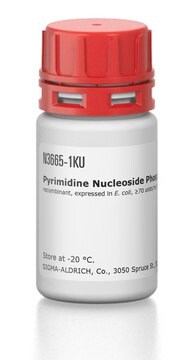SRE0006
Thymidine Phosphorylase, recombinant from Escherichia coli
recombinant, expressed in E. coli, Suitable for manufacturing of diagnostic kits and reagents, buffered aqueous solution, ≥500 units/mL
Synonym(s):
Gliostatins, PD-ECGF, Thymidine:orthophosphate deoxy-D-ribosyltransferase
Sign Into View Organizational & Contract Pricing
All Photos(2)
About This Item
CAS Number:
MDL number:
UNSPSC Code:
12352204
NACRES:
NA.54
Recommended Products
recombinant
expressed in E. coli
Quality Level
form
buffered aqueous solution
concentration
≥500 units/mL
technique(s)
inhibition assay: suitable
color
colorless to yellow
solubility
soluble
water: soluble
NCBI accession no.
UniProt accession no.
application(s)
diagnostic assay manufacturing
shipped in
wet ice
storage temp.
2-8°C
Gene Information
Escherichia coli ... deoA(948901)
Looking for similar products? Visit Product Comparison Guide
General description
Research area: CELL SIGNALING
The E. coli thymidine phosphorylase shares 40% sequence homology with the human sequence, which is identical to the angiogenic agent platelet-derived endothelial growth factor. The purified E. coli enzyme has been shown to stimulate blood vessel growth in chick chorioallantoic membrane assays.
The E. coli thymidine phosphorylase shares 40% sequence homology with the human sequence, which is identical to the angiogenic agent platelet-derived endothelial growth factor. The purified E. coli enzyme has been shown to stimulate blood vessel growth in chick chorioallantoic membrane assays.
Application
Thymidine phosphorylase has been used:
- in a study to evaluate biomarkers for advanced breast cancer patients treated with capecitabine-based first-line chemotherapy.
- in a study to investigate implications for the clinical efficacy of nucleoside analogues.
Biochem/physiol Actions
An enzyme that catalyzes the reversible conversion of thymidine to thymine. Thymidine phosphorylase is part of the pyrimidine nucleoside salvage pathway.
An enzyme that catalyzes the reversible conversion of thymidine to thymine. Thymidine phosphorylase is part of the pyrimidine nucleoside salvage pathway. This pathway allows pyrimidine bases to be recycled for nucleotide biosynthesis, while the pentose 1-phosphates are converted to intermediates of the pentose phosphate shunt and glycolysis. The E. coli thymidine phosphorylase shares 40% sequence homology with the human sequence, which has been found to be identical to the angiogenic agent platelet-derived endothelial growth factor. The purified E. coli enzyme has been shown to stimulate blood vessel growth in chick chorioallantoic membrane assays.
Thymidine phosphorylase catalyzes the reversible conversion of thymidine to thymine. Thymidine phosphorylase is part of the thymidine salvage pathway and pyrimidine nucleoside salvage pathway. This pathway allows pyrimidine bases to be recycled for nucleotide biosynthesis, while the pentose 1-phosphates are converted to intermediates of the pentose phosphate shunt and glycolysis. The enzyme inhibits apoptosis and induces angiogenesis thereby promoting tumor growth and metastatic process. Moreover, thymidine phosphorylase inhibits vascular smooth muscle cell proliferation.
Unit Definition
One unit will convert 1.0 μmole each of thymidine and phosphate to thymine and 2-deoxyribose 1-phosphate per min at pH 7.4 at 25°C.
Preparation Note
Cloned from E. coli and produced in overexpressing E. coli
Storage Class Code
12 - Non Combustible Liquids
WGK
WGK 2
Flash Point(F)
Not applicable
Flash Point(C)
Not applicable
Choose from one of the most recent versions:
Already Own This Product?
Find documentation for the products that you have recently purchased in the Document Library.
Clinical and biochemical improvements in a patient with MNGIE following enzyme replacement.
Bridget E Bax et al.
Neurology, 81(14), 1269-1271 (2013-08-24)
Akihiko Hatano et al.
Organic & biomolecular chemistry, 11(40), 6900-6905 (2013-09-24)
Herein, we describe β-selective coupling between a modified uracil and a deoxyribose to produce functionalized nucleosides catalyzed by thymidine phosphorylase derived from Escherichia coli. This enzyme mediates nucleobase-exchange reactions to convert unnatural nucleosides possessing a large functional group such as
Thymidine phosphorylase regulates the expression of CXCL10 in rheumatoid arthritis fibroblast-like synoviocytes.
Toyoda Y, Tabata S, Kishi J, et al.
Arthritis & Rheumatology (Hoboken, N.J.), 66(3), 560-568 (2014)
Sheng-hua Zhang et al.
Cancer chemotherapy and pharmacology, 72(4), 777-788 (2013-08-27)
Capecitabine (CAP), a prodrug, needs to be converted to 5-fluorouracil by several key enzymes, including thymidine phosphorylase (TP). To improve the therapeutic index, potentiation of antitumor activity of CAP is required. In this study, we explored whether lidamycin (LDM), an
Hriday Bera et al.
Chemical biology & drug design, 82(3), 351-360 (2013-06-14)
In our lead finding program, a series of 1,2,4-triazolo[1,5-a][1,3,5]triazine derivatives were synthesized, and their in vitro thymidine phosphorylase inhibitory potential was explored. Among the different derivatives, compounds having keto group (C = O) at C7 and thioketo group (C = S) at C5 positions
Our team of scientists has experience in all areas of research including Life Science, Material Science, Chemical Synthesis, Chromatography, Analytical and many others.
Contact Technical Service





